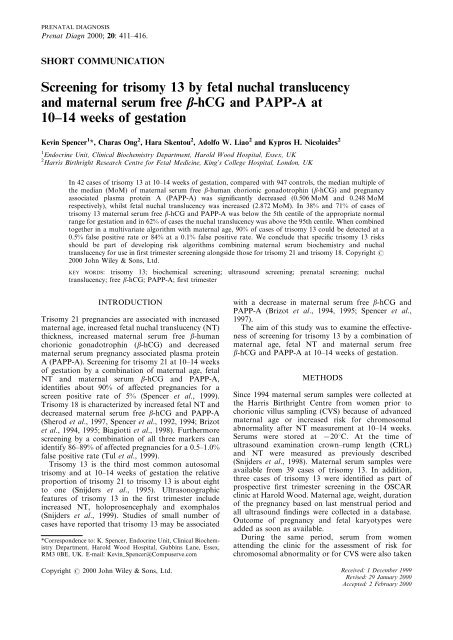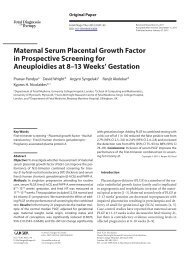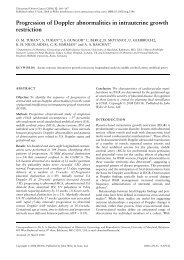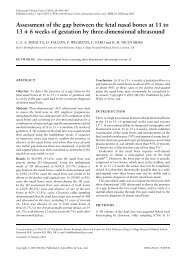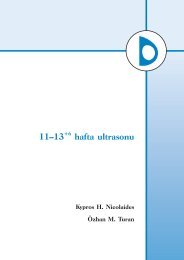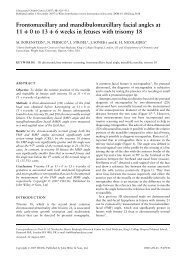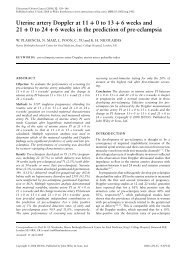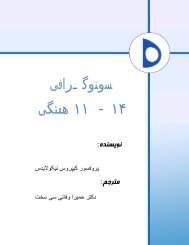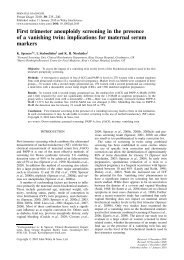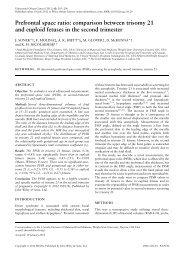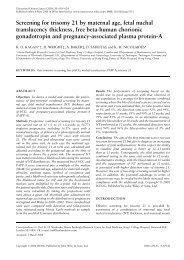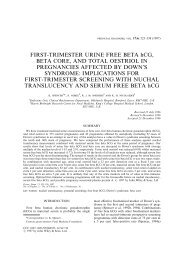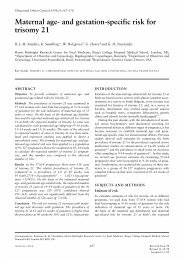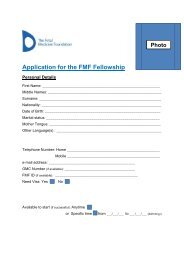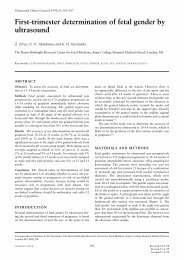Screening for trisomy 13 by fetal nuchal translucency and maternal ...
Screening for trisomy 13 by fetal nuchal translucency and maternal ...
Screening for trisomy 13 by fetal nuchal translucency and maternal ...
You also want an ePaper? Increase the reach of your titles
YUMPU automatically turns print PDFs into web optimized ePapers that Google loves.
PRENATAL DIAGNOSIS<br />
Prenat Diagn 2000; 20: 411±416.<br />
SHORT COMMUNICATION<br />
<strong>Screening</strong> <strong>for</strong> <strong>trisomy</strong> <strong>13</strong> <strong>by</strong> <strong>fetal</strong> <strong>nuchal</strong> <strong>translucency</strong><br />
<strong>and</strong> <strong>maternal</strong> serum free b-hCG <strong>and</strong> PAPP-A at<br />
10±14 weeks of gestation<br />
Kevin Spencer 1 *, Charas Ong 2 , Hara Skentou 2 , Adolfo W. Liao 2 <strong>and</strong> Kypros H. Nicolaides 2<br />
1 Endocrine Unit, Clinical Biochemistry Department, Harold Wood Hospital, Essex, UK<br />
2 Harris Birthright Research Centre <strong>for</strong> Fetal Medicine, King's College Hospital, London, UK<br />
In 42 cases of <strong>trisomy</strong> <strong>13</strong> at 10±14 weeks of gestation, compared with 947 controls, the median multiple of<br />
the median (MoM) of <strong>maternal</strong> serum free b-human chorionic gonadotrophin (b-hCG) <strong>and</strong> pregnancy<br />
associated plasma protein A (PAPP-A) was signi®cantly decreased (0.506 MoM <strong>and</strong> 0.248 MoM<br />
respectively), whilst <strong>fetal</strong> <strong>nuchal</strong> <strong>translucency</strong> was increased (2.872 MoM). In 38% <strong>and</strong> 71% of cases of<br />
<strong>trisomy</strong> <strong>13</strong> <strong>maternal</strong> serum free b-hCG <strong>and</strong> PAPP-A was below the 5th centile of the appropriate normal<br />
range <strong>for</strong> gestation <strong>and</strong> in 62% of cases the <strong>nuchal</strong> <strong>translucency</strong> was above the 95th centile. When combined<br />
together in a multivariate algorithm with <strong>maternal</strong> age, 90% of cases of <strong>trisomy</strong> <strong>13</strong> could be detected at a<br />
0.5% false positive rate or 84% at a 0.1% false positive rate. We conclude that speci®c <strong>trisomy</strong> <strong>13</strong> risks<br />
should be part of developing risk algorithms combining <strong>maternal</strong> serum biochemistry <strong>and</strong> <strong>nuchal</strong><br />
<strong>translucency</strong> <strong>for</strong> use in ®rst trimester screening alongside those <strong>for</strong> <strong>trisomy</strong> 21 <strong>and</strong> <strong>trisomy</strong> 18. Copyright #<br />
2000 John Wiley & Sons, Ltd.<br />
KEY WORDS: <strong>trisomy</strong> <strong>13</strong>; biochemical screening; ultrasound screening; prenatal screening; <strong>nuchal</strong><br />
<strong>translucency</strong>; free b-hCG; PAPP-A; ®rst trimester<br />
INTRODUCTION<br />
Trisomy 21 pregnancies are associated with increased<br />
<strong>maternal</strong> age, increased <strong>fetal</strong> <strong>nuchal</strong> <strong>translucency</strong> (NT)<br />
thickness, increased <strong>maternal</strong> serum free b-human<br />
chorionic gonadotrophin (b-hCG) <strong>and</strong> decreased<br />
<strong>maternal</strong> serum pregnancy associated plasma protein<br />
A (PAPP-A). <strong>Screening</strong> <strong>for</strong> <strong>trisomy</strong> 21 at 10±14 weeks<br />
of gestation <strong>by</strong> a combination of <strong>maternal</strong> age, <strong>fetal</strong><br />
NT <strong>and</strong> <strong>maternal</strong> serum b-hCG <strong>and</strong> PAPP-A,<br />
identi®es about 90% of affected pregnancies <strong>for</strong> a<br />
screen positive rate of 5% (Spencer et al., 1999).<br />
Trisomy 18 is characterized <strong>by</strong> increased <strong>fetal</strong> NT <strong>and</strong><br />
decreased <strong>maternal</strong> serum free b-hCG <strong>and</strong> PAPP-A<br />
(Sherod et al., 1997, Spencer et al., 1992, 1994; Brizot<br />
et al., 1994, 1995; Biagiotti et al., 1998). Furthermore<br />
screening <strong>by</strong> a combination of all three markers can<br />
identify 86±89% of affected pregnancies <strong>for</strong> a 0.5±1.0%<br />
false positive rate (Tul et al., 1999).<br />
Trisomy <strong>13</strong> is the third most common autosomal<br />
<strong>trisomy</strong> <strong>and</strong> at 10±14 weeks of gestation the relative<br />
proportion of <strong>trisomy</strong> 21 to <strong>trisomy</strong> <strong>13</strong> is about eight<br />
to one (Snijders et al., 1995). Ultrasonographic<br />
features of <strong>trisomy</strong> <strong>13</strong> in the ®rst trimester include<br />
increased NT, holoprosencephaly <strong>and</strong> exomphalos<br />
(Snijders et al., 1999). Studies of small number of<br />
cases have reported that <strong>trisomy</strong> <strong>13</strong> may be associated<br />
*Correspondence to: K. Spencer, Endocrine Unit, Clinical Biochemistry<br />
Department, Harold Wood Hospital, Gubbins Lane, Essex,<br />
RM3 0BE, UK. E-mail: Kevin_Spencer@Compuserve.com<br />
with a decrease in <strong>maternal</strong> serum free b-hCG <strong>and</strong><br />
PAPP-A (Brizot et al., 1994, 1995; Spencer et al.,<br />
1997).<br />
The aim of this study was to examine the effectiveness<br />
of screening <strong>for</strong> <strong>trisomy</strong> <strong>13</strong> <strong>by</strong> a combination of<br />
<strong>maternal</strong> age, <strong>fetal</strong> NT <strong>and</strong> <strong>maternal</strong> serum free<br />
b-hCG <strong>and</strong> PAPP-A at 10±14 weeks of gestation.<br />
METHODS<br />
Since 1994 <strong>maternal</strong> serum samples were collected at<br />
the Harris Birthright Centre from women prior to<br />
chorionic villus sampling (CVS) because of advanced<br />
<strong>maternal</strong> age or increased risk <strong>for</strong> chromosomal<br />
abnormality after NT measurement at 10±14 weeks.<br />
Serums were stored at x20uC. At the time of<br />
ultrasound examination crown±rump length (CRL)<br />
<strong>and</strong> NT were measured as previously described<br />
(Snijders et al., 1998). Maternal serum samples were<br />
available from 39 cases of <strong>trisomy</strong> <strong>13</strong>. In addition,<br />
three cases of <strong>trisomy</strong> <strong>13</strong> were identi®ed as part of<br />
prospective ®rst trimester screening in the OSCAR<br />
clinic at Harold Wood. Maternal age, weight, duration<br />
of the pregnancy based on last menstrual period <strong>and</strong><br />
all ultrasound ®ndings were collected in a database.<br />
Outcome of pregnancy <strong>and</strong> <strong>fetal</strong> karyotypes were<br />
added as soon as available.<br />
During the same period, serum from women<br />
attending the clinic <strong>for</strong> the assessment of risk <strong>for</strong><br />
chromosomal abnormality or <strong>for</strong> CVS were also taken<br />
Copyright # 2000 John Wiley & Sons, Ltd. Received: 1 December 1999<br />
Revised: 29 January 2000<br />
Accepted: 2 February 2000
412<br />
K. SPENCER ET AL.<br />
<strong>and</strong> the same data were entered in the database. From<br />
the stored sera 947 controls were selected with<br />
matching <strong>for</strong> <strong>maternal</strong> <strong>and</strong> gestational age. The<br />
inclusion criteria were normal karyotype at CVS or<br />
birth of a ba<strong>by</strong> without abnormalities. These controls<br />
have been part of two previous studies (Spencer et al.,<br />
1999; Tul et al., 1999).<br />
Maternal serum free b-hCG <strong>and</strong> PAPP-A were<br />
measured using the Kryptor analyserÐa rapid r<strong>and</strong>om<br />
access immunoassay analyser using Time Resolved<br />
Ampli®ed Cryptate Emmission (TRACE) technology<br />
<strong>and</strong> the CIS automated immuno¯uorescent assays<br />
(CIS UK Ltd., High Wycombe, Bucks, UK). The<br />
stored samples were measured over a period of ®ve<br />
days. The between day precision of these assays has<br />
been previously reported (Spencer et al., 1999). The<br />
three samples collected during prospective screening<br />
were analysed within 20 min of blood collection.<br />
Statistical analysis<br />
Regression analysis was carried out to derive the<br />
relationship between free b-hCG <strong>and</strong> PAPP-A with<br />
gestational age. All analyte measurements were converted<br />
to MoMs using the derived medians from<br />
normal pregnancies at the same gestation. Correction<br />
of each MoM <strong>for</strong> <strong>maternal</strong> weight was also per<strong>for</strong>med<br />
using the reciprocal-linear regression weight correction<br />
procedure of Neveux et al. (1996). Assessment of the<br />
per<strong>for</strong>mance of various marker combinations as<br />
potential screening procedures was examined using<br />
st<strong>and</strong>ard statistical modeling techniques (Royston <strong>and</strong><br />
Thompson, 1992). We used the measured parameters<br />
<strong>for</strong> PAPP-A <strong>and</strong> free b-hCG <strong>and</strong> the reported<br />
parameters <strong>for</strong> <strong>nuchal</strong> <strong>translucency</strong> from 95 476<br />
normal control pregnancies (Snijders et al., 1998;<br />
Nicolaides et al., 1998) <strong>and</strong> the measured parameters<br />
<strong>for</strong> the <strong>trisomy</strong> <strong>13</strong> cases. Using these population<br />
parameters, a series of 15 000 r<strong>and</strong>om MoM values<br />
were selected <strong>for</strong> each marker from within the<br />
distributions of the affected <strong>and</strong> the unaffected<br />
pregnancies. These values were then used to calculate<br />
likelihood ratios <strong>for</strong> the various marker combinations.<br />
The likelihood ratios were then used together with the<br />
age-related risk <strong>for</strong> <strong>trisomy</strong> <strong>13</strong> in the ®rst trimester<br />
(Snijders et al., 1995) to calculate the expected<br />
detection rate of affected pregnancies, at a ®xed false<br />
positive rate, in a population with the <strong>maternal</strong> age<br />
distribution of pregnancies in Engl<strong>and</strong> <strong>and</strong> Wales<br />
(OPCS, 1986±1994).<br />
Figure 1ÐProbability plot of log 10<br />
<strong>trisomy</strong> <strong>13</strong><br />
PAPP-A MoM in cases of<br />
Figure 2ÐProbability plot of log 10 free b-hCG MoM in cases of<br />
<strong>trisomy</strong> <strong>13</strong><br />
Copyright # 2000 John Wiley & Sons, Ltd. Prenat Diagn 2000; 20: 411±416.
MATERNAL SERUM SCREENING FOR TRISOMY <strong>13</strong> 4<strong>13</strong><br />
Table 1ÐMaternal age, gestational age <strong>and</strong> crown±rump length <strong>for</strong> the <strong>trisomy</strong> <strong>13</strong><br />
<strong>and</strong> control groups<br />
Trisomy <strong>13</strong><br />
Mean (range)<br />
Controls<br />
Mean (range)<br />
Maternal age (years) 35.53 (26±45) 35.1 (15±47)<br />
Gestational age (days) 84.9 (77±96) 85.1 (72±99)<br />
Crown±rump length (mm) 56.3 (44±74.8) 60.4 (38±85)<br />
Median length of storage (days) 1011 (0±2330) 546 (102±1811)<br />
Number of cases 42 947<br />
RESULTS<br />
Table 1 summarizes the data of the <strong>trisomy</strong> <strong>13</strong> <strong>and</strong> the<br />
control groups. The mean <strong>maternal</strong> age was 35.5 years<br />
<strong>for</strong> the <strong>trisomy</strong> <strong>13</strong> group <strong>and</strong> 35.1 years <strong>for</strong> the<br />
controls; the gestational age based on CRL was 84.9<br />
days <strong>for</strong> the <strong>trisomy</strong> <strong>13</strong> group <strong>and</strong> 85.1 <strong>for</strong> the<br />
controls. These differences were not statistically<br />
signi®cant.<br />
Free b-hCG, PAPP-A <strong>and</strong> NT all ®tted a gaussian<br />
distribution after log 10 trans<strong>for</strong>mation in both the<br />
control group (Spencer et al., 1999; Nicolaides et al.,<br />
1998) <strong>and</strong> the <strong>trisomy</strong> <strong>13</strong> group, with Kolmogorov±<br />
Smirnov <strong>and</strong> Anderson Darling tests showing linearity<br />
at the 0.01 probability levels after exclusion of three<br />
outliers <strong>for</strong> PAPP-A (exclusion criteria outsideÐthree<br />
SD's). Figures 1, 2 <strong>and</strong> 3 show the normal probability<br />
plots <strong>for</strong> the markers in the <strong>trisomy</strong> <strong>13</strong> group.<br />
In cases of <strong>trisomy</strong> <strong>13</strong>, the median MoM was<br />
signi®cantly lower than the controls <strong>for</strong> the markers<br />
free b-hCG <strong>and</strong> PAPP-A with medians of 0.506 <strong>and</strong><br />
0.248 respectively. For NT the median MoM was<br />
signi®cantly higher (2.872 MoM) than in the controls.<br />
The st<strong>and</strong>ard deviation of log 10 free b-hCG <strong>and</strong><br />
PAPP-A MoM in the <strong>trisomy</strong> <strong>13</strong> group was 0.277<br />
<strong>and</strong> 0.296 respectively, whilst that <strong>for</strong> log 10 NT MoM<br />
was 0.238. These values are similar to those observed<br />
in a large series of <strong>trisomy</strong> 21 cases (Spencer et al.,<br />
1999). As reported in our previous study (Spencer<br />
et al., 1999), in the control group no signi®cant<br />
correlation was found between <strong>maternal</strong> age <strong>and</strong> log 10<br />
MoM of the markers NT, free b-hCG <strong>and</strong> PAPP-A<br />
(correlation coef®cientsÐ0.010, 0.036, 0.036, respectively)<br />
or between NT <strong>and</strong> free b-hCG <strong>and</strong> PAPP-A<br />
(correlation coef®cientsÐ0.057 <strong>and</strong> 0.000). There was<br />
a small signi®cant correlation between free b-hCG <strong>and</strong><br />
PAPP-A (r=0.160).<br />
In the <strong>trisomy</strong> <strong>13</strong> group no signi®cant correlation<br />
was found between log 10 MoM of the markers free b-<br />
hCG <strong>and</strong> PAPP-A (0.<strong>13</strong>86), NT <strong>and</strong> PAPP-A (0.0964)<br />
<strong>and</strong> NT <strong>and</strong> free b-hCG (0.0095). Table 2 summarizes<br />
the distribution parameters <strong>for</strong> the control population<br />
from our previous study (Spencer et al., 1999) <strong>and</strong> <strong>for</strong><br />
the <strong>trisomy</strong> <strong>13</strong> cases from this study. Figures 4, 5 <strong>and</strong> 6<br />
show the individual cases of <strong>trisomy</strong> <strong>13</strong> plotted against<br />
gestational age <strong>for</strong> each of the markers. Free b-hCG<br />
MoM , was below the 5th centile (0.397 MoM) in 16<br />
(38%) of the cases with <strong>trisomy</strong> 18. PAPP-A was below<br />
Table 2ÐDistribution parameters <strong>for</strong> the <strong>trisomy</strong> <strong>13</strong> <strong>and</strong><br />
control populations<br />
Free b-hCG PAPP-A<br />
NT<br />
Log 10 mean controls 0.004 x0.004 0.000<br />
Log 10 SD controls 0.2558 0.2431 0.120<br />
Log 10 mean affected x0.2943 x0.5817 0.4<strong>13</strong>0<br />
Log 10 SD affected 0.277 0.296 0.238<br />
10th centile controls (MoM) 0.47 0.48 0.69<br />
50th centile controls (MoM) 1.00 1.00 1.00<br />
90th centile controls (MoM) 2.16 1.98 1.40<br />
10th centile affected (MoM) 0.23 0.08 1.28<br />
50th centile affected (MoM) 0.506 0.248 2.872<br />
90th centile affected (MoM) 1.30 0.61 4.93<br />
Figure 3ÐProbability plot of log 10 NT MoM in cases of <strong>trisomy</strong> <strong>13</strong><br />
NT data <strong>for</strong> control population from Nicoladies et al. (1998).<br />
Copyright # 2000 John Wiley & Sons, Ltd. Prenat Diagn 2000; 20: 411±416.
414<br />
K. SPENCER ET AL.<br />
Table 3ÐTrisomy <strong>13</strong> detection rates at various false positive rates (FPR) <strong>for</strong> different<br />
marker combinations modelled against the age distribution of pregnancies in Engl<strong>and</strong><br />
<strong>and</strong> Wales<br />
Marker combination<br />
Detection at a<br />
FPR of 0.1%<br />
Detection at a<br />
FPR of 0.5%<br />
MA+free b-hCG 32% 40%<br />
MA+PAPP-A 52% 64%<br />
MA+NT 68% 79%<br />
MA+NT+free b-hCG 70% 79%<br />
MA+NT+PAPP-A 84% 90%<br />
MA+free b-hCG+PAPP-A 58% 69%<br />
MA+NT+free b-hCG+PAPP-A 84% 90%<br />
Figure 4ÐPAPP-A MoM in 42 cases of <strong>trisomy</strong> <strong>13</strong> in the ®rst trimester. Dotted line is the 5th centile of normal<br />
Figure 5ÐFree b-hCG MoM in 42 cases of <strong>trisomy</strong> <strong>13</strong> in the ®rst trimester. Dotted line is the 5th centile of normal<br />
Copyright # 2000 John Wiley & Sons, Ltd. Prenat Diagn 2000; 20: 411±416.
MATERNAL SERUM SCREENING FOR TRISOMY <strong>13</strong> 415<br />
Figure 6ÐNT MoM in 42 cases of <strong>trisomy</strong> <strong>13</strong> in the ®rst trimester. Dotted line is the 95th centile of normal<br />
the 5th centile (0.385 MoM) in 30 (71%) cases <strong>and</strong> NT<br />
was above the 95th centile (1.57 MoM) in 26 (62%)<br />
cases.<br />
When the observed statistical parameters were used<br />
in the mathematical model of a population with the<br />
<strong>maternal</strong> age distribution of pregnancies in Engl<strong>and</strong><br />
<strong>and</strong> Wales, the estimated detection rates using various<br />
marker combinations with <strong>maternal</strong> age at a ®xed false<br />
positive rate of 0.1% varied from 32% with <strong>maternal</strong><br />
age <strong>and</strong> free b-hCG to 90% with <strong>maternal</strong> age, NT,<br />
PAPP-A <strong>and</strong> free b-hCG (Table 3).<br />
DISCUSSION<br />
The ®ndings of this study demonstrate that in <strong>trisomy</strong><br />
<strong>13</strong> pregnancies at 10±14 weeks of gestation both<br />
<strong>maternal</strong> serum free b-hCG <strong>and</strong> PAPP-A are<br />
decreased (0.506 MoM <strong>and</strong> 0.248 MoM respectively)<br />
<strong>and</strong> that <strong>fetal</strong> NT is increased. These ®ndings are<br />
compatible with the results of previous observations.<br />
In a small series of nine cases, P<strong>and</strong>ya et al. (1995)<br />
showed increased NT in cases of <strong>trisomy</strong> <strong>13</strong> <strong>and</strong><br />
Snijders et al. (1998) showed that 72% of cases (33/46)<br />
were above the 95th centile <strong>for</strong> NT thickness. For free<br />
b-hCG Brizot et al. (1995) showed a median MoM of<br />
0.3 from eight cases, Spencer et al. (1997) showed a<br />
median MoM of 0.64 from ®ve cases <strong>and</strong> Brambati<br />
et al. (1997) showed a median MoM of 0.19 from three<br />
cases. Similarly <strong>for</strong> PAPP-A, Brizot et al. (1994)<br />
showed a median MoM of 0.25 from eight cases <strong>and</strong><br />
Brambati et al. (1997) showed a median MoM of 0.67<br />
from three cases. There<strong>for</strong>e, <strong>trisomy</strong> <strong>13</strong> pregnancies<br />
present with a similar pattern of markers (low<br />
<strong>maternal</strong> serum free b-hCG <strong>and</strong> PAPP-A <strong>and</strong> high<br />
<strong>fetal</strong> NT) as <strong>trisomy</strong> 18 pregnancies (Tul et al., 1999).<br />
Speci®c risks <strong>for</strong> <strong>trisomy</strong> <strong>13</strong> can now be calculated<br />
from our observed distributions of the markers <strong>and</strong><br />
the apriori <strong>maternal</strong> age <strong>and</strong> gestation-related risks<br />
(Snijders et al., 1995). This is unlike the situation in the<br />
second trimester when it has been suggested that<br />
speci®c risk algorithms cannot be constructed <strong>for</strong><br />
<strong>trisomy</strong> <strong>13</strong> (Saller et al., 1999).<br />
The use of rapid immunodiagnostic technology <strong>for</strong><br />
the measurement of the biochemical markers has<br />
allowed the introduction of a one-stop clinic <strong>for</strong><br />
assessment of risk <strong>for</strong> <strong>fetal</strong> abnormalities (OSCAR)<br />
in which during a 1 h visit the patient undergoes pretest<br />
counselling, biochemical <strong>and</strong> ultrasound assessment<br />
with combined risk estimation, prior to receiving<br />
post-test counselling. <strong>Screening</strong> <strong>for</strong> <strong>trisomy</strong> 21 in such<br />
a programme identi®es about 90% of affected pregnancies<br />
<strong>for</strong> a screen positive rate of 5% (Spencer et al.,<br />
1999). In such a system it is also possible to identify<br />
86% of <strong>trisomy</strong> 18 pregnancies <strong>for</strong> a 0.5% false positive<br />
rate (Tul et al., 1999) <strong>and</strong> as suggested <strong>by</strong> this study,<br />
about 84% of <strong>trisomy</strong> <strong>13</strong> pregnancies <strong>for</strong> a 0.1% false<br />
positive rate.<br />
ACKNOWLEDGEMENTS<br />
We acknowledge the support of CIS in providing the<br />
instrument <strong>and</strong> reagents <strong>for</strong> this study. The work at<br />
the Harris Birthright Centre is supported <strong>by</strong> a grant<br />
from the Fetal Medicine Foundation (Charity no.<br />
1037116).<br />
REFERENCES<br />
Biagiotti R, Cariati E, Brizzi L, Capelli G, D'Agata A. 1998.<br />
Maternal serum screening <strong>for</strong> <strong>trisomy</strong> 18 in the ®rst trimester of<br />
pregnancy. Prenat Diagn 18: 907±9<strong>13</strong>.<br />
Brambati B, Macri JN, Tului L, Hallahan TW, Krantz DA, Elberti<br />
E. 1997. First-trimester <strong>fetal</strong> aneuploidy screening: <strong>maternal</strong><br />
serum PAPP-A <strong>and</strong> free b-hCG. In <strong>Screening</strong> <strong>for</strong> Down Syndrome<br />
Copyright # 2000 John Wiley & Sons, Ltd. Prenat Diagn 2000; 20: 411±416.
416<br />
K. SPENCER ET AL.<br />
in the First Trimester, Grudzinskas JG, Ward RHT (eds). RCOG<br />
Press: London; <strong>13</strong>5±147.<br />
Brizot ML, Snjiders RJM, Bersinger NA, Kuhn P, Nicolaides KH.<br />
1994. Maternal serum pregnancy-associated plasma protein A <strong>and</strong><br />
<strong>fetal</strong> <strong>nuchal</strong> <strong>translucency</strong> thickness <strong>for</strong> the prediction of <strong>fetal</strong><br />
trisomies in early pregnancy. Obstet Gynecol 84: 918±922.<br />
Brizot ML, Snjiders RJM, Butler J, Bersinger NA, Nicolaides KH.<br />
1995. Maternal serum hCG <strong>and</strong> <strong>nuchal</strong> <strong>translucency</strong> thickness <strong>for</strong><br />
the prediction of <strong>fetal</strong> trisomies in the ®rst trimester of pregnancy.<br />
Br J Obstet Gynecol 102: 127±<strong>13</strong>2.<br />
Neveux LM, Palomaki GE, Larivee DA, Knight GJ, Haddow JE.<br />
1996. Re®nements in managing <strong>maternal</strong> weight adjustment <strong>for</strong><br />
prenatal screening results. Prenat Diagn 16: 1115±1119.<br />
Nicolaides KH, Snijders RJM, Cuckle HS. 1998. Correct estimation<br />
of parameters <strong>for</strong> ultrasound <strong>nuchal</strong> <strong>translucency</strong> screening.<br />
Prenat Diagn 18: 519±521.<br />
Of®ce of Population Censuses Surveys. 1986±1994. Birth Statistics,<br />
Series FM1, Nos <strong>13</strong>±21, HMSO: London.<br />
P<strong>and</strong>ya PP, Snijders RJM, Johnson SJ, Brizot M, Nicolaides KH.<br />
1995. <strong>Screening</strong> <strong>for</strong> <strong>fetal</strong> trisomies <strong>by</strong> <strong>maternal</strong> age <strong>and</strong> <strong>fetal</strong><br />
<strong>nuchal</strong> <strong>translucency</strong> thickness at 10 to 14 weeks of gestation. Br<br />
J Obstet Gynecol 102: 957±962.<br />
Royston P, Thompson SG. 1992. Model based screening <strong>for</strong> risk<br />
with application to Down's syndrome. Stats Med 11: 257±268.<br />
Saller DN, Canick JA, Blitzer MG, Palomaki GE, Schwartz S,<br />
Blackmore KJ, Haddow JE. 1999. Second trimester <strong>maternal</strong><br />
serum analyte levels associated with <strong>fetal</strong> <strong>trisomy</strong> <strong>13</strong>. Prenat<br />
Diagn 19: 8<strong>13</strong>±816.<br />
Sherod C, Sebire NJ, Soares W, Snijders RJM, Nicolaides KH. 1997.<br />
Prenatal diagnosis of <strong>trisomy</strong> 18 at the 10±14 week ultrasound<br />
scan. Ultrasound Obstet Gynecol 10: 387±390.<br />
Snijders RJM, Sebire NJ, Nicolaides KH. 1995. Maternal age <strong>and</strong><br />
gestational age-speci®c risk <strong>for</strong> chromosomal defects. Fetal Diagn<br />
Ther 10: 356±367.<br />
Snijders RJM, Noble P, Sebire N, Souka A, Nicolaides KH, <strong>for</strong> the<br />
Fetal Medicine Foundation First Trimester <strong>Screening</strong> Group.<br />
1998. UK multicentre project on assessment of risk of <strong>trisomy</strong> 21<br />
<strong>by</strong> <strong>maternal</strong> age <strong>and</strong> <strong>fetal</strong> <strong>nuchal</strong>-<strong>translucency</strong> thickness at 10±14<br />
weeks of gestation. Lancet 351: 343±346.<br />
Snijders RJ, Sebire NJ, Nayar R, Souka A, Nicolaides KH. 1999.<br />
Increased <strong>nuchal</strong> <strong>translucency</strong> in <strong>trisomy</strong> <strong>13</strong> fetuses at 10±14<br />
weeks of gestation. Am J Med Genet 86: 205±207.<br />
Spencer K, Macri JN, Aitken DA, Connor JM. 1992. Free b-hCG as<br />
a ®rst trimester marker of <strong>fetal</strong> <strong>trisomy</strong>. Lancet 339: 1480<br />
Spencer K, Aitken DA, Crossley JA, McCaw G, Berry E, Anderson<br />
R, Connor JM, Macri JN. 1994. First trimester biochemical<br />
screening <strong>for</strong> <strong>trisomy</strong> 21: the role of free beta-hCG, alpha<br />
fetoprotein <strong>and</strong> pregnancy associated plasma protein A. Ann Clin<br />
Biochem 31: 447±454.<br />
Spencer K, Noble P, Snijders RJM, Nicolaides KH. 1997. First<br />
trimester urine free beta-hCG, beta case <strong>and</strong> total oestriol in<br />
pregnancies affected <strong>by</strong> Down syndrome: implications <strong>for</strong> ®rst<br />
trimester screening with <strong>nuchal</strong> <strong>translucency</strong> <strong>and</strong> serum free betahCG.<br />
Prenat Diagn 17: 525±538.<br />
Spencer K, Souter V, Tul N, Snijders R, Nicolaides KH. 1999. A<br />
rapid screening program <strong>for</strong> <strong>trisomy</strong> 21 at 10±14 weeks' using<br />
<strong>fetal</strong> <strong>nuchal</strong> <strong>translucency</strong>, <strong>maternal</strong> serum free b-hCG <strong>and</strong> PAPP-<br />
A. Ultrasound Obstet Gynecol <strong>13</strong>: 231±237.<br />
Tul N, Spencer K, Noble P, Chan C, Nicolaides KH. 1999.<br />
<strong>Screening</strong> <strong>for</strong> <strong>trisomy</strong> 18 <strong>by</strong> <strong>fetal</strong> <strong>nuchal</strong> <strong>translucency</strong> <strong>and</strong><br />
<strong>maternal</strong> serum free beta hCG <strong>and</strong> PAPP-A at 10±14 weeks of<br />
gestation. Prenat Diagn 19: 1035±1042.<br />
Copyright # 2000 John Wiley & Sons, Ltd. Prenat Diagn 2000; 20: 411±416.


